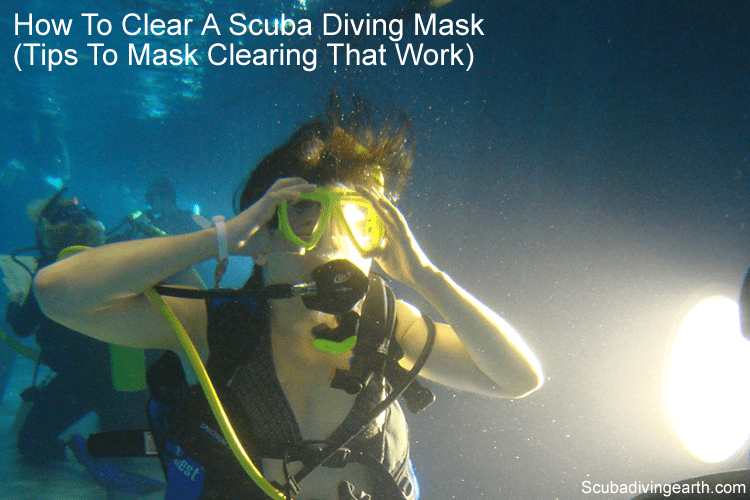
How to clear a scuba diving mask and why it’s important to learn mask clearing underwater
The technique that most beginner scuba divers struggle with when learning to scuba dive is mask clearing. I took great pleasure in helping my students to master this important skill.
In the above image, the trainee scuba diver is clearing their mask the wrong way. This should be mastered using just one hand only. See below why this is important.
4 simple steps to clear a scuba diving mask underwater like a pro diver:
- Take a small breath from your regulator;
- Tilt your head slightly backwards;
- Use your index finger to press on the top of the mask;*
- Breathe into your mask from your nose to force the water out from the bottom of the mask’s skirt.
The best way to do more diving is to book yourself on a scuba diving liveaboard. You can check the latest and best deals on liveaboards using the following window:
* Pro Tip: It’s important to master the skill of mask clearing using just one hand. Please read on to discover why.
Mask clearing is an important skill to learn, as you never know when you may need to clear your mask on a dive. But as with all things scuba, confidence comes with practice. For scuba diving safety confidence is key.
You might like to read this article that includes 27 scuba diving safety rules. 12 of which are extremely important to know.
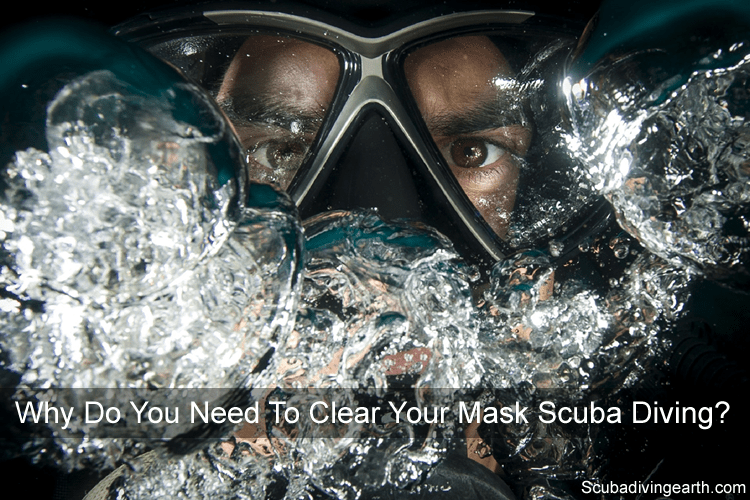
Why do you need to clear your mask scuba diving?
Before going on to explain how to clear a scuba diving mask, it’s important to understand why this is a skill you need to master in the first place.
Reasons why you need mask clearing skill:
- You have a leaking mask.
- Your mask may get knocked off by another scuba diver’s fins.
- Laughing underwater can make a mask leak.
- A strong current or a running tide can pull your mask off.
- Clearing a fogged up mask.
- Training of beginner scuba divers.
- As a result of a scuba diver in trouble.
1. If you have a mask that leaks on a dive you need to know how to clear the water
A scuba mask can leak for any number of reasons. The first of which is an ill-fitting mask which was not checked correctly when it was bought. In this article on essential scuba diving equipment, I explain how to check your mask fit when buying it.
A mask may leak if you have facial hair like a beard or a mustache. Although a technique that does work if you have a beard is to use some Vaseline. Put the vasaline on your mustache where the facial hair contacts the skirt of the mask.
An older mask or a mask that has a damaged skirt may also leak on a dive too.
If you have a leaking mask, the chances are you’ll need to clear it at some point in the dive. Depending on the length of the dive, you may need to clear it several times.
2. Your mask may get knocked off by another scuba diver’s fins
It is possible, and it does happen, that your mask may get knocked by another scuba diver. What can happen is your mask gets caught by another diver’s fins. This can either cause it to leak or rip it off your face completely.
If either of these happen, you’ll need to clear the mask of whatever water has got in. However, if your mask gets ripped off completely, you’ll have to perform a full mask clear.
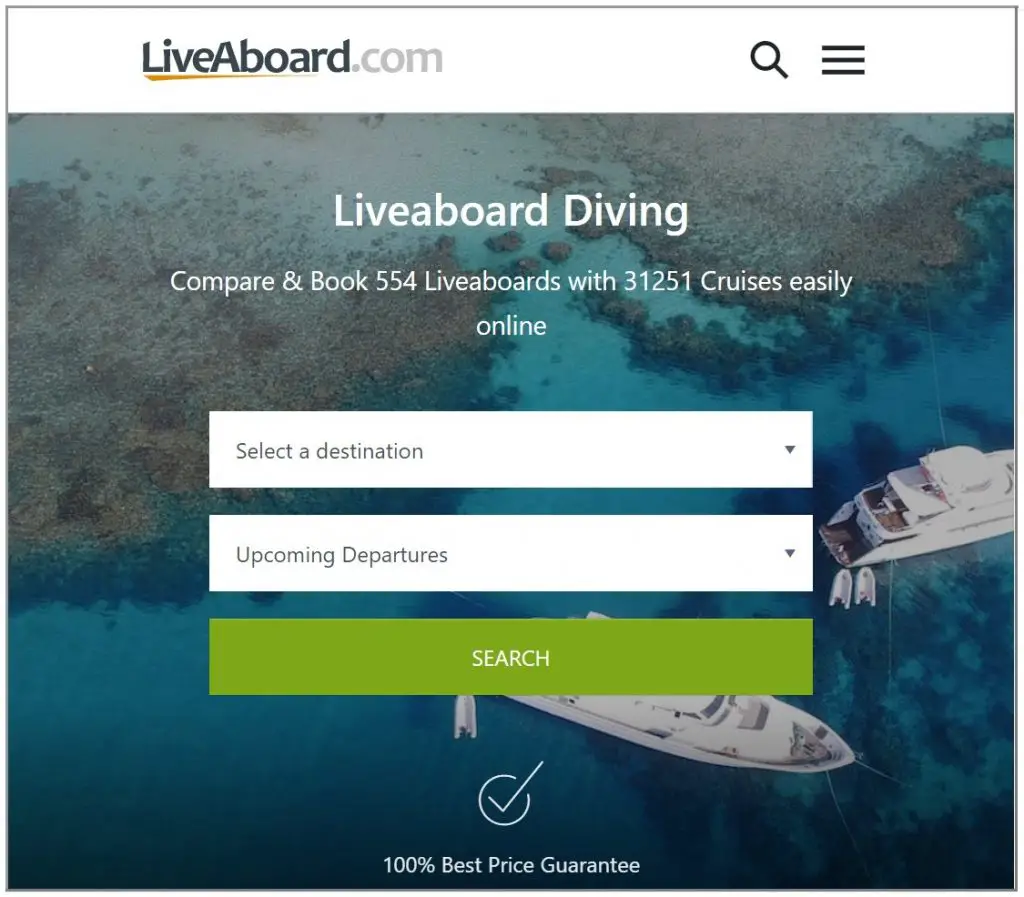
3. Laughing underwater can make a mask leak
Possibly the most common occurrence for me where I’ve had to clear my mask is through laughing underwater.
The time I laughed most was seeing my buddy almost jump backwards several feet underwater when she came face to face with an oceanic whitetip shark. Don’t worry she was ok, I was able to clear my mask and the shark simply swam by without a care in the world!
When you laugh underwater the ‘crows-feet’ around your eyes create gaps under the mask skirt. As a result water leaks into the mask. Finish laughing then clear your mask..
4. A strong current or a running tide can pull your mask off
If you find yourself hanging onto a rope on a scuba dive with a fast-running tide there’s a chance your mask may get pulled off your face.
Pro Tip: Master the scuba diving mask clear technique using just one hand only. You may need your other hand to hold on to a shot line in a current.
This happened to me on a dive on the Thistlegorm Wreck in the Red Sea. It was at the end of the dive when the tide started to flow fast. On our ascent up the shot line my mask was pushed across my face and as a result leaked.
This is one of those times when I needed one hand to hold onto the rope (to avoid being swept away), leaving the other hand free for clearing my mask.
5. Clearing a fogged up mask requires a mask clear
One technique I’ve used and is included in this article: ‘How to stop your dive mask from fogging.‘. In this article I explain how you can fill your mask with a bit of water to clear the mask fog. This can happen if you’ve either forgotten to use some form of mask anti-fog, or if what you used hasn’t worked properly.
Of course if you let water into your mask to clear the fogging, you’ll need to clear the water afterwards.
6. Training of beginner scuba divers
The other time you may need to clear your own mask, is if you get involved with training other scuba divers to clear their masks. This is what I have done in the past when I was a BSAC scuba diver trainer.
To teach this skill of mask clearing you need to be confident and well practiced at the technique yourself.
7. Scuba diver in trouble can lead to a mask full of water
If you’re in the unfortunate situation where you need to come to the rescue of a fellow diver, in the panic a mask can get knocked or ripped off. If this does happen, not only will you have to take control, but you will also have to clear your mask of water too.
This is one of the times when you may need to keep one hand free to hold on to your fellow diver. Which will mean you have only one hand to perform the mask clear.
How to clear a scuba diving mask
The technique of clearing a mask is better demonstrated by way of a video. For this reason, I have found what I consider to be an extremely good video on scuba dive mask clearing. It is demonstrated by Daniel Smith. Daniel is a BSAC trainer at Delmar Dive Club, so thank you Daniel.
bsac mask clearing demonstrated by Delmar dive club Stanley cove Leicestershire. This video makes it easy to understand how to do a mask clear underwater.
How do you practice mask clearing?
As with all scuba diving skills practice makes perfect. This is no different for mask clearing.
What are is the four step process to become confident at mask clearing:
- The partial mask clear.
- Half-full mask clear.
- The full mask clear.
- Mask removal and replacement and clear.
Take each step slowly. When you first perform each step do so in water that’s shallow enough you can stand up. Master each step before moving onto the next.
If you want to learn more about how to practice these mask clearing steps, each one is explained in detail below.
1. How to clear a partially flooded scuba mask
- Stay in shallow water so you can stand up.
- Kneel on the bottom so your head is submerged with roughly 1-2 feet of water above your head.
- Fill your mask with a small amount of water by lifting your mask slightly away from your face being careful at this stage not to flood the whole mask.
- Take a small breath from your regulator.
- Tilt your head slightly backwards.
- Use your index finger to press on the top of the mask.
- Breathe into your mask from your nose to force the water out from the bottom of the mask’s skirt.
2. The half-full dive mask clearing technique
Steps one and two are the same as a partial clear above.
But this time fill your mask with more water. The water in your mask should be roughly level with the top of your nose. But your eyes shouldn’t be covered.
Follow steps four to seven in the partial clear above.
3. The full dive mask clear
For the full mask clear you need to follow the exact same steps in the partial clear, except this time you need to fill your mask full of water. It’s okay if you prefer to close your eyes.
It is the full mask clear that prepares you for the mask removal and replacement. See below.
As you are clearing a mask full of water you may need blow through your nose for a bit longer to make sure all the water is cleared. If not, take another breath and blow out again.
4. How to perform a dive mask removal and replacement
To perform a mask removal and replacement is a case of preparing yourself for the skill in the first place.
The simple steps of how to perform a mask removal and replacement are as follows:
- Take a few shallow breaths from your regulator to prepare yourself. You need to be calm.
- It’s okay to close your eyes before you remove your mask.
- Only when you feel ready remove your mask completely.
- Be careful not to take water up your nose and continue to breathe from your regulator.*
- Put the mask strap around the front of the mask.
- Place the mask on your face and pull the strap around the back of your head.
- Make sure the mask is correctly fitted and feels comfortable.
- Take a breath from your regulator.
- Tilt your head backwards.
- Press your index finger on the top of the mask.
- Blow out through your nose to force the water out from the bottom of the mask’s skirt.
* Removing your mask for the first time underwater will feel strange when you do it for the first time. It is therefore important you do this skill in shall water where you can stand up when it’s done the first time.
When you’re learning the skill of mask clearing, always perfect the skill of clearing a partially flooded mask first, before your progress to a mask removal and replacement.
The best way to learn and practice this skill is to begin in the shallow end of a swimming pool. This way should anything go wrong, you can simply stand up. As you gain confidence and improve your technique progress into the deep end of the swimming pool.
Why is it important to use just one hand for dive mask clearing?
I always taught mask clearing using the one handed method. It doesn’t matter whether you use one finger as explained above or if you use your hand like Daniel does in the video. But the important thing to learn is that you do it with just one hand and not two.
The reason for this is that you may need your other hand for something else. One of the reasons why your mask may get flooded, as explained above, was if you’re in a running tide or current. If this is the reason for a flooded mask, you will need one hand to hold on to the guide robe, whilst you use the other hand to performer the mask clear.
The other reason this may be important is if you are saving another diver. In this case you’ll need to use one hand to hold your buddy, so you’ll only have one hand free to clear your mask.
More Reading: How do I get a dive buddy? (5 easy ways to find a dive buddy)
There may be other reasons that you need to keep a spare hand, which may be as simple as needing to hold something. Whatever the reason, make sure you perfect the dive mask clearing technique one-handed.
I hope you enjoyed this article about how to clear a scuba diving mask
I’d love to hear from you. Tell us about your adventures of diving and snorkeling, in the comments below. Please also share your photos. Either from your underwater cameras or videos from your waterproof Gopro’s!
If this article hasn’t answered all of your questions. If you have more questions either about snorkeling or scuba diving (or specifically about how to clear a scuba diving mask), please comment below with your questions.
There will also be many more articles about scuba diving (and snorkeling) for you to read and learn about these fabulous sports.
Have fun and be safe!

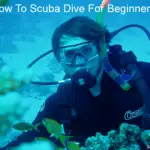

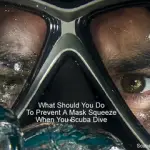
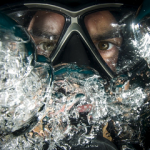
Hi, I am very interested in getting open water certified however my concern is my nose gets stuffed up easily and this makes it difficult to clear my mask. I wouldn’t want to invest in getting certified if I cannot properly clear my mask. Is there a way to clear your mask without using your nose?
Hi Jason, thank you for your question and comment. I’m afraid there is no other way to clear your mask if it gets filled with water than to use your nose. But possibly more of a problem than clearing your mask is equalising your ears. For example, do you have problems when you fly with your ears not clearing? If you do, this means your Eustachian tubes (these are small passageways that connect your throat to your middle ear) may also be blocked too, and if this is the case you won’t be able to dive until you are able to rectify this problem.
I suggest you speak to your doctor about your nose problem and see what they suggest before you get certified to dive.
Enjoyed this post. This has helped me with maintaining my scuba diving mask. Thanks again!